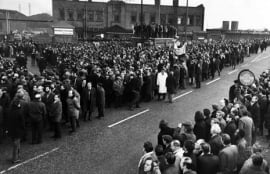January 2015 marks 43 years since the 1972 miners’ strike – the first national miners’ strike since the 1926 general strike. Matt Wood reviews The World on our Backs, a vivid description of the ’72 strike, which demonstrated what could be achieved when the working class is united.
January 2015 marks 43 years since the 1972 miners’ strike – the first national miners’ strike since the 1926 general strike.
Between 1962 and 1971 mining increased its productivity by 42 per cent. Despite this, after years of below-inflation pay deals, miners had become some of the worst paid industrial workers in the country. Nationalisation in 1947 saw an initial surge in hope amongst the miners who were glad to see the back of the unscrupulous private owners, but disillusionment soon set in. The newly nationalised industry was required to subsidise private industry with cheap coal and until 1958 the National Coal Board (NCB) was not allowed to build up financial reserves to fund future investment. After oil came on stream from the North Sea and also further afield – sending the price of coal down – the Conservative government told the NCB that it had to stand on its own two feet after it had subsidised capitalist expansion for two decades.
All of this serves to remind us that the state serves the interests of the class it represents – in this case, the capitalist class, who saw that the coal industry could more effectively be planned by the capitalist state and act as a subsidy to private industry. It was the Atlee Labour government that embarked on a programme of nationalisation after the war; but it was the Tories that kept these reforms after their re-election in the 1950s.
Malcolm Pitt’s The World on our Backs – The Kent Miners and the 1972 Miners’ Strike is an excellent account of both the history of the Kent coalfield and the 1972 strike itself. The aptly named Pitt was a miner, a trade unionist and a Communist himself, working at Tilmanstone Colliery (one of the four pits that had existed in East Kent – the last, Betteshanger, closing in 1989).
The Kent coalfield started when the mineral was discovered by the Channel Tunnel company in 1890. A rash of speculators started to drill in the east of the county but, partly because the coal proved so difficult to extract – only four collieries survived. Kent miners were mainly immigrants from the rest of the UK. After the failure of the 1926 general strike many miners moved to the Kent coalfields to get away from pit closures, bosses’ lockouts and blacklists. The same happened in the 1960s, as the pit closure programme left miners jobless. For the Kent coalfield though, this meant an influx of some militant miners who knew the importance of mounting an effective resistance against pit closures and penny-pinching bosses. In 1961, redundancy notices at Betteshanger caused a stay-down strike and the result was a lifting of the redundancies and an agreement to open a new seam.
The first half of this book deals with the history of the coalfield and the life of the miner. Pitt does his best to describe how a seam is actually mined and the conditions down a pit. We learn about the union, political struggles, the social and cultural habits of the mining communities, and the attitude of the mostly rural Kentish community to their subterranean neighbours.
The second half is an account of the 1972 strike itself. The Kent miners were tasked with picketing across the southeast and London. Pickets on the mines was the least of it – the success of the strike depended on stopping the places where coal was used. 3,500 Kent NUM miners “found themselves responsible for picketing the largest concentration of power stations, docks and railway depots in Great Britain”.
Miners all over the country appealed directly to other members of the working class to aid them in their fight. In contrast to the 1984 strike, although there was some prevarication by the TUC, other unions did support the miners – although somewhat unevenly and more because of a combination of the energy of the NUM pickets and rank and file support for the miners amongst the transport unions.
At Dover docks however, a mass picket was required. Non-union lorry drivers kept driving through pickets and it was not until the second week of the strike that an agreement was reached between the NUM and Corralls – the company that moved coal out of Dover docks. The two parties agreed that coal could be delivered to hospitals, schools and old people’s homes, but that any other non-essential deliveries were off-limits. Pitt writes “The Dover Agreement, which created a form of workers’ control in Britain unknown since the General Strike in 1926, was a direct result of the show of force by the miners…”
Pitt’s book is a detailed account of pickets turning lorries back, of NUM delegations to power station shop stewards, and a real sense of how for seven weeks in 1972 nothing moved without the consent of the working class. The climax of the strike, and the final victory, was at Saltley Gate in Birmingham, where engineers at the coking depot joined with the miners and closed the gates. From there, it was clear that the government was defeated.
It is the 1974 strike that goes down in history as the strike that brought down the Heath government; but as Pitt says, this was largely a phoney war. There were no flying pickets and the result was decided at the ballot box with the incoming Labour government settling quickly with the NUM. By contrast, the 1972 strike stands as testament to what can be achieved by united action across the working class, sector by sector. This is also a lesson that, had it been learned by some of the TUC leadership, could have resulted in victory in 1984-85 when the miners, as the most advanced section of the working class, faced the onslaught of Thatcher and her backers in the ruling class.
The World on our Backs – The Kent Miners and the 1972 Miners’ Strike, by Malcolm Pitt, (Lawrence and Wishart, London: 1979).






